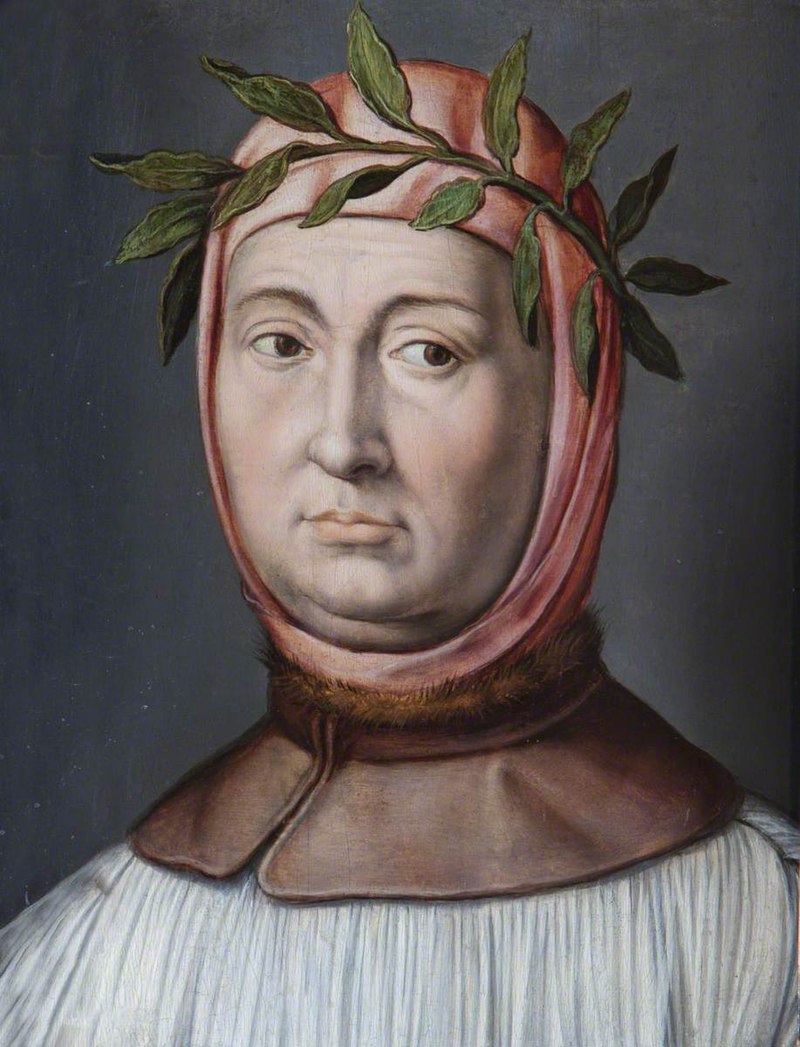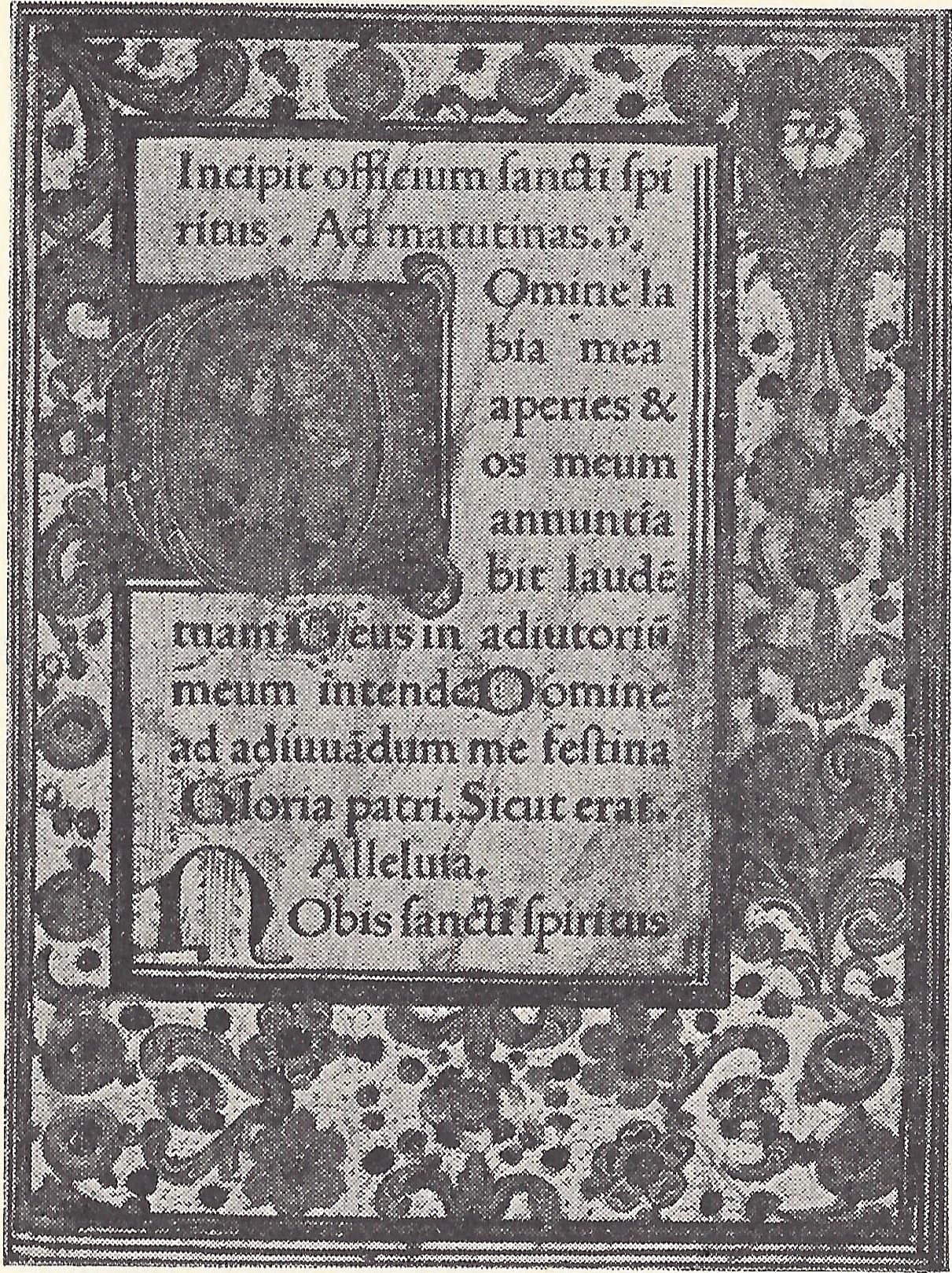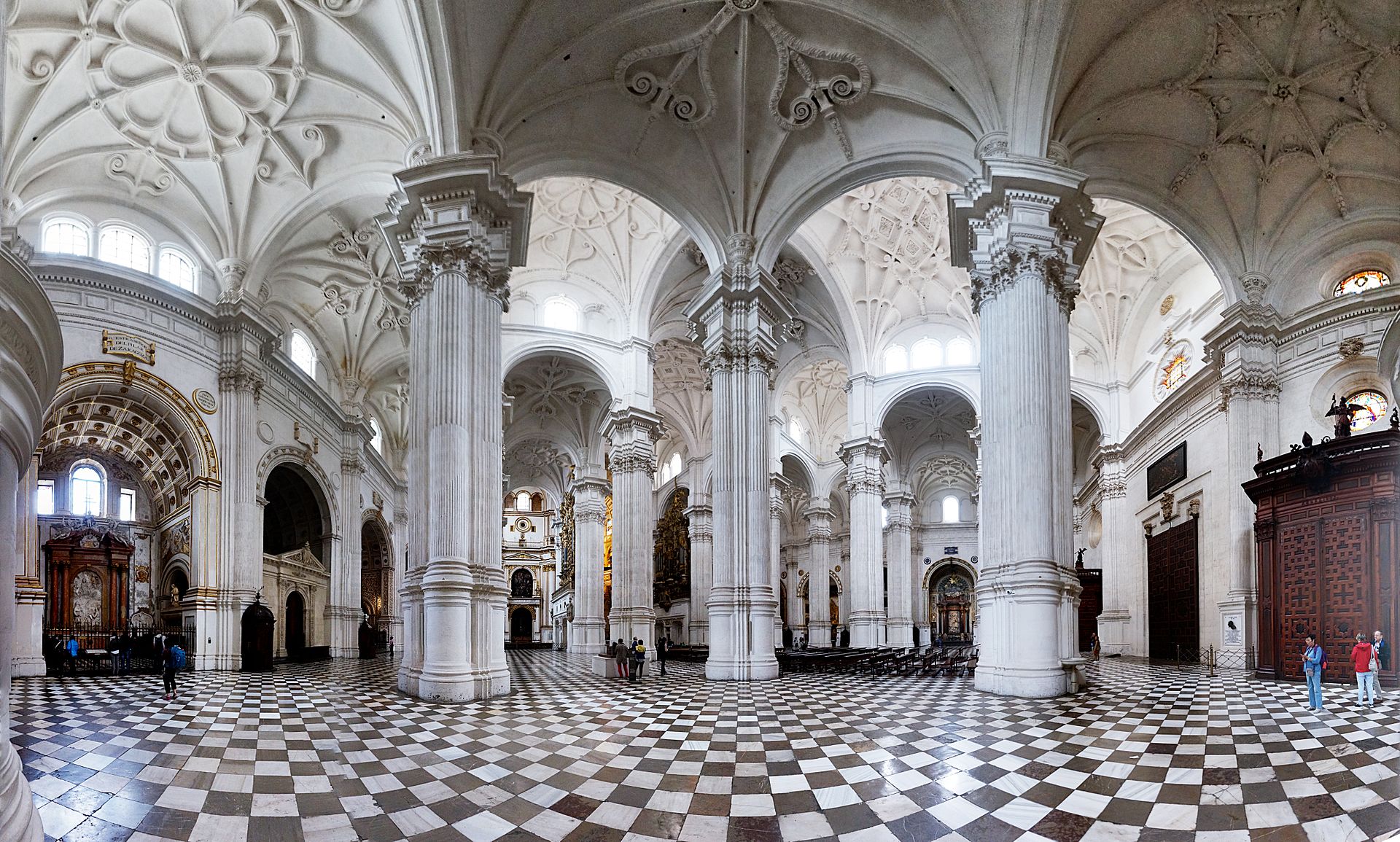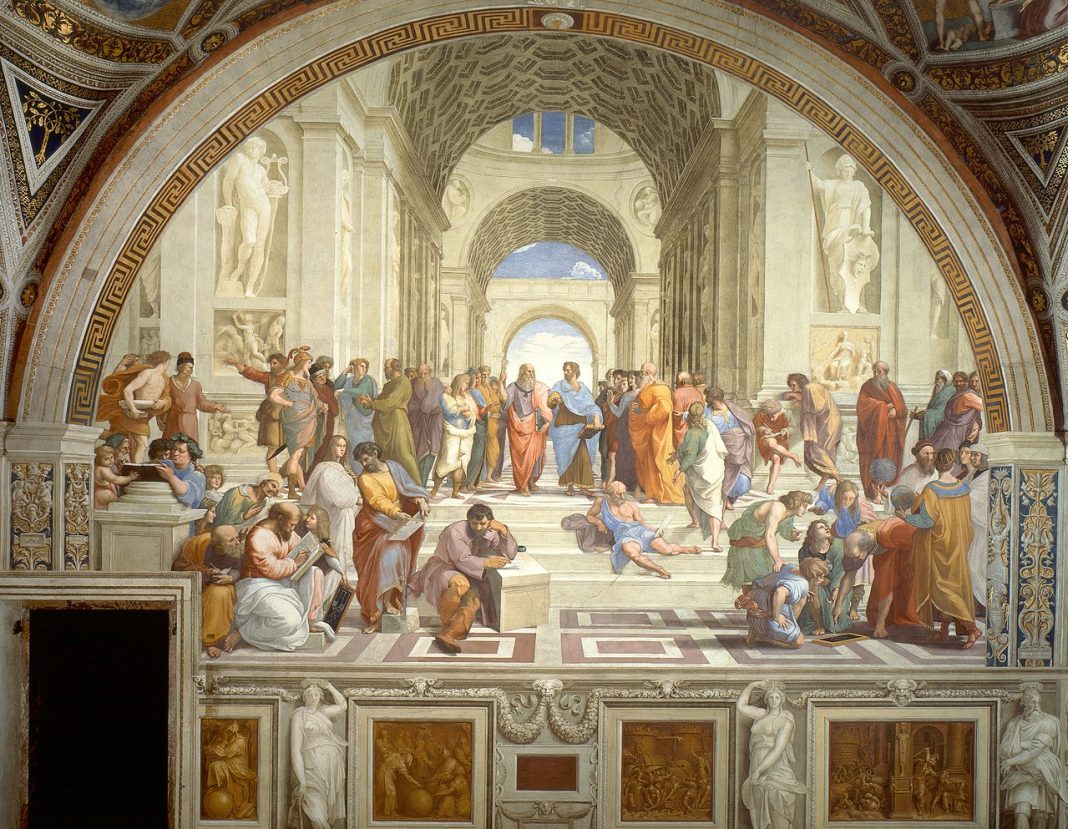The following is an excerpt (pages 546-558) from Ancient and Medieval History (1944) by Francis S. Betten, S.J. Although some information may be outdated, the Catholic historical perspective it provides remains pertinent. Use the link at the bottom of post to read the previous/following pages. Use the Search box above to find specific topics or browse using the Resources tab above.
CHAPTER XLVII
THE RENAISSANCE
The period of the Renaissance concludes the era of religious unity. Its name is taken from one of its most remarkable features, the “renaissance,” rebirth, of ancient classic literature. It partly overlapped the preceding period and even began at different times in the different countries. Nor does it show the same characteristics in all lands and nations.
THE RENAISSANCE PROPER: THE REVIVAL OF CLASSICAL LITERATURE
676. Origin. — About the middle of the fourteenth century there arose in Italy a new fervor in the appreciation of the ancient classic works of the Roman authors. The study of the masterpieces of Cicero, Virgil, and others had indeed never died out during the Middle Ages. They were studied, imitated, quoted. Above all they were faithfully transcribed by the monks of the monasteries (§ 408). Latin, too, always remained the language of the clergy, the educated, and the schools, though the great teachers of Scholasticism (§ 616 ff.) adapted it to the needs of their branches of learning. Now the Latin tongue itself became the object of careful study. Hand in hand with this went a greater interest in the beauties of nature.
St. Francis of Assisi (§ 584) sang wonderful hymns to glorify God in the beauties of His visible creation. The same love of nature is a prominent feature in the grandest work of Dante (§ 615). Francis Petrarch (1304-1374) is considered the real father and chief promoter of humanism, as the new study is frequently called. The host of his followers grew from year to year. Classic Latin became the everyday language of these enthusiasts. They employed it in conversation, in public productions, in their private letters. They eagerly searched for manuscripts of the ancient works, which they found chiefly in the monasteries.

Humanism spread fast through the various countries of Christendom and took hold of all classes of people who could afford to give time to such pursuits. The laity vied with the clergy in literary and scientific endeavor. The possession of libraries was no longer confined to ecclesiastics; no palace was thought to be complete unless it could boast of a goodly collection of books. Moreover, “in the general interest in classical learning . . . woman took a significant part. From the beginning of the revival we find the record of her literary tastes and accomplishments side by side with those of the leading men of her time.”
677. Attitude toward Religion. — In its best representatives humanism was far from being opposed to the Church. Petrarch himself says: “Let us admire their [the ancient writers’] intellectual gifts, but in such wise as to reverence the Creator of these gifts. Let us have compassion on the errors of these men while we congratulate ourselves and acknowledge that out of mercy, without any merit of our own, we have been favored above our forefathers by Him who has hidden his secrets from the wise and graciously manifested them to little ones. . . . The real wisdom of God is Christ.”
Not all the humanists harbored the same sentiments. There were not lacking those who would gladly have thrown everything overboard that was not in full accord with the views of the pagans whose writings they admired. They imitated not only the elegance of diction to be found in the works of these pagan writers, but also the immorality of their lives. Humanists of this stamp we call radicals, those who remained faithful Christians, conservatives. The radicals, as well as others who did not go quite so far, often made the Church and all her ministers the butt of their ridicule.
The Church as such never antagonized humanism. True, a few popes did not positively favor it, because other interests of the Church demanded attention more urgently. Most of the popes, however, were its liberal promoters. In Rome brilliant minds were sure of finding every kind of encouragement. In fact, without the active support and generous assistance of ecclesiastical dignitaries humanism could never have obtained so general a hold upon the nations of western Christendom.
678. Humanism in Various Countries. — In Italy humanists of both classes were strongly represented. Some of the radicals, in addition to leading the loosest kind of life, went so far as even to plan the death of such persons as seemed opposed to their revolutionary projects. Boccaccio, one of the originators of the humanistic movement, gave to literature some of the vilest productions. He died, however, in union with the Church, and in his last hours besought his friends to prevent as much as possible the spread and reading of his works.
Two monks, William Snelling and William Hadley, who had made their studies in Italy, introduced humanism into England. It found a liberal protector in Cardinal Wolsey. Blessed Thomas More, sometime the king’s chancellor, encouraged famous humanists and was no mean scholar himself. Blessed Bishop Fisher of Rochester, Dean Colet, and others were not only ardent humanists but thorough and practical churchmen.
The first German humanists harmoniously combined great linguistic abilities with humble submission to the doctrines and laws of their religion. Some of their successors, however, indulged in violent attacks, chiefly by means of satire, upon Scholasticism, the religious orders, the priesthood and Papacy, and upon sacred ceremonies and pious customs.
679. Two facts contributed greatly to the further development and rapid spread of the humanistic tendencies. The first was the influx of Greek scholars from the East. They came to participate in several councils. The constant attacks of the Turks caused many to flee to the West in search of new homes. This was still more the case in the first years after the conquest of Constantinople (1453). These visitors and refugees acquainted the Italian humanists, and through them those of other countries, with the Greek language and the works of the Greek poets, orators, and historians, all of which had been very little known so far. The soil was well prepared for the new seed. The masterpieces of Hellas were added to the humanistic program, and enthusiastically studied. It was a new impetus for the progress of the classical revival. Greek, however, never became quite so generally known as Latin.
The other fact, which was of far greater importance still, was the invention of printing, which reduced the cost of books enormously and thus facilitated the efforts of teachers and students (§681).
680. One great result of the humanistic movement was a
gradual change in the curriculum of the faculty of arts in the universities (§ 617). This faculty now began to aim primarily at training the young student to a proficiency in classical Latin and Greek and to a certain degree of familiarity with the literature of both these languages. For several centuries this proficiency in the classics remained the indispensable condition for the study of all the higher branches, and is still so, the world over, for the study of theology.
Humanism was, however, not narrowed down to Latin and Greek. It included Hebrew and other idioms useful for the understanding of the Bible. In fact it created a new branch of study, philology, which strives for a deeper insight into the nature of languages.
INVENTIONS, DISCOVERIES, ARTS
681. The Invention of Printing – All the books so far used in the world had been handwritten, and were, consequently, very expensive. A tome of moderate size was a precious possession. A library of a few hundred volumes represented an almost princely fortune. This scarcity of books had ever proved the greatest obstacle to general education. This was now to be changed. About 1450 John Gutenberg of Mainz (Mayence) invented the art of printing.

Produced at Naples in 1478. The D of the word Domine is shaped into a large initial with a miniature picture in it. These initials as well as the wide margins found in many of the early printed books were commonly hand-painted in very rich colors. Books printed before 1500 are called incunabula, cradle prints. The term implies that at that period the art of printing was still “in the cradle.” As a matter of fact many, if not most, incunabula belong to the finest productions of the art. This illustration also shows how some of the most beautiful incunabula have become disfigured by careless handling.
The printing of pictures from entire wooden plates (wood engraving) had been practiced in Germany for some time. Even words and short texts were cut in wood and thus printed. Laurenz Coster, of Harlem, began to cut the individual letters separately, so that he could use the same type in various words and sentences. He even produced metal type which he cast in sand molds. Thus he printed a number of books, chiefly small schoolbooks, such as Latin grammars. He is rightly considered the inventor of “movable type.” Gutenberg probably got the idea from Coster. But he substituted metal molds for the sand molds, and thus was able to cast a large number of types from one mold. He also invented a method to make the production of type very rapid. These two improvements meant an essential change. Hence, though Coster’s merits must not be underrated, Mainz is the real birthplace of printing. It was from Mainz that the art spread to other places, even to Coster’s own country, the Netherlands.
“This invention,” says a great historian, “the mightiest and most important of civilization next to the art of writing, gave as it were wings to the human mind.” “Most commendable,” wrote Pope Innocent VIII in 1487, “is the art of printing, inasmuch as good and useful books are thereby easily multiplied.”
The art spread rapidly. From the start it was most liberally patronized by ecclesiastics and monasteries. The ancient Benedictine abbey of Subiaco was the first to set up a printing press in Italy, and was followed by many convents in other countries. In 1474 William Caxton introduced printing into England. Next to Germany, Italy possessed the greatest number of presses. By the end of the century every large city in Europe had its printing establishments.
Naturally the printers produced the books that were in demand. Before the year 1500 there had appeared more than a hundred editions of the Latin Bible, and dozens of translations of Holy Writ into the several vernacular languages. Alongside these were editions of the great ecclesiastical writers, “the Fathers of the Church,” together with Greek and Latin classics, grammars and other schoolbooks, catechisms and prayer books, and collections of religious and secular songs. This allows us to judge of the intellectual wants of the people. The trade in manuscripts, necessarily very limited, now gave way to a brisk international book trade with its centers in the prominent cities of Europe.

682. Renaissance Art. — In Italy, where there still remained many of the ancient edifices and monuments, — some in ruins, others in varying stages of preservation, — the new movement led to an imitation of the Roman manner of building. The Gothic was abandoned and another style of architecture grew up, called the Renaissance style. Like the Romanesque (§ 625) it employed the round arch, and reintroduced many of the features found in the structures of the ancients. It often made use of the cupola. If we may deplore the passing of the graceful Gothic, we should remember that the mind of the people was no longer that of the thirteenth century. The new style easily adapted itself to all kinds of buildings, secular as well as ecclesiastical. Its best productions are characterized by a majestic beauty. One of its greatest creations is the present church of St. Peter in Rome. (H. T. F., “Architecture” (8).)
Painting had made great progress. The artists of the Renaissance are among the best the world has ever known. Perspective was now well observed. An improved method of handling oil colors made it possible to paint on canvas, whereas up to 1450 paintings were mainly frescoes, that is, carried out upon the freshly plastered walls or ceilings of edifices. The art became more independent of architecture.

Italian painting culminated in the eighty years from 1470 to 1550. Between these dates came the work of Leonardo da Vinci, Michael Angelo, Fra Angelico, Raphael, and scores of others. Many of these practiced more than one art; Michael Angelo was great as architect, engineer, painter, and sculptor, and he was not without fame as a poet. Germany had Albert Durer and Hans Holbein. The great period of the Flemish and Dutch art was to come later, between 1600 and 1660, with Rubens, Van Dyck, and Rembrandt. At the same time flourished the Spaniards Velazquez and Murillo. Neither France nor England produced much in this direction at this time. Several of the great artists, however, found liberal patronage in Paris and London.
683. Geographical Discoveries. — Though in the Middle Ages the common people entertained the most fantastic ideas concerning the shape of the earth, the greater minds well knew that our planet is a globe. They had no correct knowledge, however, of the distribution of land and water and of the configuration of the continents. Their world practically did not reach farther than the Mediterranean and its immediate surroundings. But in the thirteenth century Franciscan missionaries returning from the Far East reported that there was an ocean east of “Cathai” (China). Other travelers even returned by sea from Peking through the Asiatic straits and the Indian Ocean. It was therefore clear that this ocean, the existence of which had been known in some nebulous way, was not landlocked. Friar Bacon (§ 623) in his boldness advanced the idea that possibly the Atlantic Ocean was the one side of a large sea which with its other side washed the shores of China. Parts of his writings on this subject were embodied in a work which in later centuries became a favorite book of Christopher Columbus.
These speculations assumed practical shape when the Turks extended their power over all those lands which lay in the direct route to India, and thus rendered much more difficult and dangerous the commerce which had sprung up with that far-off country during the crusades.
In the fifteenth century the Portuguese entered upon a career of naval discoveries under their great Prince Henry the Navigator, and in a series of daring voyages explored the western coast of Africa. On one of these cruises Bartholomeu Dias, after sailing far into the south, was carried away by a storm to the eastward and observed that in this new and unfamiliar position he had the coast of Africa on his left hand. He had rounded the southern point of the African continent, the Cape of Good Hope. It was not before 1498, however, that Vasco da Gama actually reached India. So this country of fabulous riches became directly accessible by sea. These discoveries gave Portugal the monopoly of the Indian trade, and enabled her to build up a vast empire of colonies in the countries around the Indian Ocean.
Some ten years before this happened, Christopher Columbus approached the King of Portugal with a scheme for finding a more direct way to India by sailing due west into the Atlantic. This, he thought, must bring him to the eastern coast of India. His offers were rejected. But the high-minded Queen Isabella of Castile (§ 657) furnished him the little fleet with which, on the memorable 12th of October of the year 1492, he discovered the New World, thinking, however, that he had reached the outlying islands of India. In the course of the next fifty years Spain sent out hundreds of daring adventurers, the “conquistadores,” who conquered for her nearly all of South and Central America with their enormous treasures of gold and silver.
By these discoveries the Mediterranean lost much of its importance as a highway of trade. This was a hard blow for the Italian cities which so far had been the principal factors in the European commerce with India.
684. Copernicus. — While the educated knew that the earth is a globe, they thought that it was the center of the universe, and that the sun and the planets were moving around it (§ 341). The first to express serious doubts about this was Cardinal Nicholas Krebs, usually called, from his birthplace, Nicholas of Cusa (Kues), who died in 1464. He was followed by the Polish astronomer Copernicus, whose book setting forth the new theory appeared in 1543 and was dedicated to Pope Paul III. According to Copernicus the sun is the center of the solar system, while the earth daily revolves upon its own axis, and, together with the other planets, moves around the sun in longer intervals.
The moment was inopportune for such a theory. Luther had just declared the Bible the sole source of faith. The new system seemed to he in open conflict with the way in which Holy Scripture speaks of the movements of the sun, moon, and stars. Hence the “Reformer” and his friends staunchly opposed Copernicus’ views, which found few adherents among the Protestants. The controversy lasted seventy years, before the Catholic Church felt obliged to take a stand in this matter. In Italy Galileo Galilei advanced Copernicus’ system without, however, being able to give a single convincing proof for it. All the arguments which he adduced have since been abandoned. To save the traditional interpretation of the Bible the Church authorities in 1616 prohibited books advocating the idea of Copernicus, unless so altered as to represent it as an hypothesis and not as a fact. Scientific discussion was never forbidden, and in 1758 the prohibition was withdrawn.
A CLOSING WORD ON THE MIDDLE AGES
We are now at the end of the Middle Ages. The thousand years through which our minds have traveled saw the world united in one faith which guided the life of high and low in all its details. The same moral principles were appealed to by all, the principles which we still learn in our catechism. The same principles ruled in political life. Although the mighty did not always cheerfully submit to them, they too recognized that all men were subject to a common moral law; that king and beggar were to be judged by the same almighty and just God. There was unity in organization, the whole Christian world submitting to the successor of St. Peter in Rome, the Sovereign Pontiff. Even politically the world was united. One of the Christian princes, who had the sublime title of Emperor of the Holy Roman Empire, was the ideal head of the entire Christian commonwealth. Though finally little actual power remained to the bearer of the imperial crown, the very idea of the Holy Roman Empire recalled the fact that all states and nations really form one great human and Christian family.
During the Middle Ages the rude states of the fifth and sixth centuries assumed a more definite shape and worked out their political institutions. Constitutional government by a monarch and some sort of representation of the people became the vogue in the best times of the Middle Ages. Municipal life flourished in countless cities. The laboring classes established their wonderful organizations. The educational world devised its lower and higher schools crowned by the universities. Philosophy and theology laid out the system of Scholasticism, both comprehensive and immortal. Buildings that vie in grandeur and beauty with the greatest ever produced by man ornamented the large cities and even the country towns. Finally the intellectual cravings of the population welcomed the art of printing and were the ultimate cause of its commercial success. Medieval study led to the discovery of new worlds. A medieval thinker was the first to state that the earth revolves around the sun.
The Middle Ages were a great time in spite of the cases of tyranny, cruelty, and oppression which disfigure many of the pages of its history. And even the criminals, royal criminals included, retained deep in their hearts the Christian faith, and very rarely refused to acknowledge the wrongfulness of their actions and to be reconciled to God and men, at least in the face of death.
Yet like all great periods of history the Middle Ages, too, had in themselves the germs of further development. They did not mark a final stage. In methods of government, in arts and sciences, and even in the utterances of genuine piety real progress was made. Unfortunately the last years of the great period contained also the germs of deterioration. In politics the beginnings appeared of greater absolutism of the rulers. In the realm of religion we discern a tendency to overdo certain pious practices and to lay less stress than before on a truly moral life, while at the same time many members of clergy and hierarchy are no longer giving the example of reproachless virtue. Ambitious men, applying principles foreign to the Middle Ages, may use these conditions as a pretext for the disparagement of medieval achievements. But a considerable heritage of good has nevertheless passed to following generations. We may safely say that whatever is good in the later progress of mankind is based upon the inheritance we have received from medieval man.


